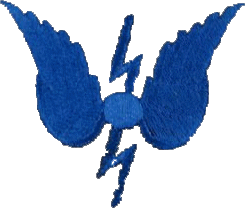|
|
|
|
|
DATE OF DESIGN | |
1935 |
|
FREQUENCY RANGE | |
MF - 375-500 kc/s:
IF - 1200-3000 kc/s (seven reselected frequencies) - I/F because the set is wholly commercial and doesn't conform to the Service Frequency markings, which in this case would be M/F also.
|
|
POWER SUPPLIES | |
Type 12A Rotary Converters run from ships 12V supply.
Type 12B Rotary Converters run from 36V battery supply for TX HT.
For TX filaments 12V battery : for RX HT from 144V battery and RX filaments from 2V battery.
See Further Reading - Power Supply Schematics. |
|
RANGE IN MILES. | |
The approximate range on M/F is 200 miles and for I/F out to approximately 1000 miles. |
|
TYPE OF SET (VALVES USED) | |
VALVE |
|
WAVEFORM | |
CW, ICW and RT |
|
ASSOCIATED WAVEMETER. | |
G9 |
|
METHOD OF PRODUCING OSCILLATIONS | |
Master Oscillator. This is free tuning on M/F and by choosing that position, the leaf spring shown in this picture top left marked 48, is permanently closed allowing the magnetic key to be keyed by the Morse key and any frequency in that range to be selected, coarse and fine tuning it to suit.

However, when the I/F position is chosen, the leaf spring is open [open circuit] UNLESS one of the 'posts' marked A-G is uppermost forcing the leaf spring arm shut, the transmitter cannot be keyed. Since each 'post' is aligned to a dial set [which represents a specific frequency], the I/F side can only use one of 7 preset frequencies taken from the range of 1200-3000 kc/s. In the picture above, 'post A' is uppermost [forcing the leaf spring shut] and it is set to 178 approximately. When a frequency change is necessary, say from 'A' to 'C' which is pre-tuned to 136, the initial movement anticlockwise of the main dial takes 'post A' away from the upper pin allowing the arm to drop opening the leaf spring, until the dial 'post C' pushes the arm back to its closed position. Only then can the Morse key/magnetic key be used again on the new frequency of 'C'. |
|
WHERE USED/FITTED | |
Type TW12 and its associated receiver the 394E are commercial sets which have been adopted for Naval use in small craft. The Type TW12A consists of the TW12 AND 394E and necessary ships supplies. The Type TW12B consists of the TW12, the 394E and a Naval receiver, the CSB. The 'A' is fitted into MTB's and motor M/S {minesweeping} boats etc. The 'B' is fitted into A/S, M/S Trawlers etc.
|
|
FURTHER READING | |
|
|
PHOTOS, SCHEMATICS, DOCUMENTS | |
|
|
NOTES. | |
Receiver. The associated receiver is the Type 394E. Its date of design is 1936 and it has a frequency range of 150-3160 kc/s. The receiver is a TRF and has two stages of RF amplification, a detector and one stage of AF amplification.
|



